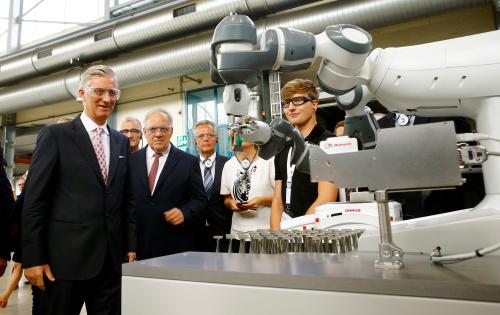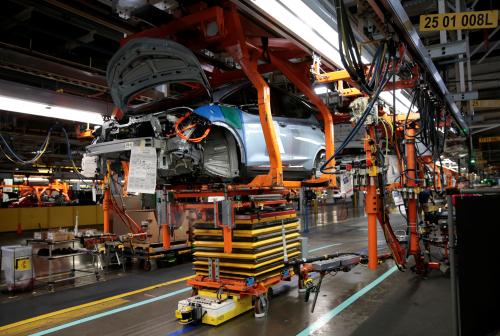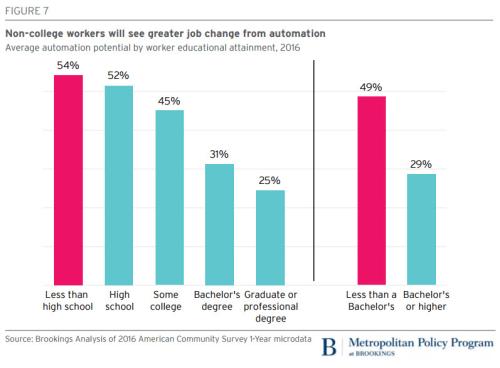At the end of each week, one of the rotating editors for Future Development—Shanta Devarajan, Wolfgang Fengler, Indermit Gill, or Homi Kharas—provides recommended literature on a specific development topic.
The future of work has received renewed attention due the rise of populist movements across Europe, the United States, and beyond. In fact, the Future Development Reads series has featured many reflections on the topic, and the World Bank just published an insightful report about The Future of Manufacturing-Led Development. The assumption is that part of the frustration among citizens is linked to job losses and lack of perspectives in traditional occupations and industries.
The McKinsey Global Institute just published a new report—What the future of work will mean for jobs, skills, and wages—which makes a brave attempt to quantify job losses and gains across 11 occupations and six major economies. Its key finding is that there will be enough work for everyone; it will just be new work. History would suggest that the fears of an end to work are unfounded.
“Over time, labor markets adjust to changes in demand for workers from technological disruptions, although at times with depressed real wages,” the report states; however, “The transitions will be very challenging—matching or even exceeding the scale of shifts out of agriculture and manufacturing we have seen in the past.”
There is a dilemma of weak winners and strong losers, in which workers displaced by automation are easily identified but not the new jobs created: “New jobs that are created indirectly from technology are less visible and spread across different sectors and geographies.” If history is any guide, you can expect that 8-9 percent of the labor demand in 2030 “will be in new types of occupations that have not existed before.”
The McKinsey report makes a useful distinction between partial and full automation noting that“few occupations—less than 5 percent—consist of activities that can be fully automated… [Whereas] in about 60 percent of occupations, at least one-third of the constituent activities could be automated.” In a baseline scenario—which assumes automation of 15 percent of current activities—there will still be more than 100 million jobs relocated.
The potential impact of automation on employment varies by occupation and sector. Activities most susceptible to automation include physical ones in predictable environments, such as operating machinery and preparing fast food. Collecting and processing data are two other categories of activities that increasingly can be done better and faster by machines. Globally, McKinsey estimates that more than 250 million new jobs could be created from the impact of rising incomes on consumer goods alone, with up to an additional 50 million to 85 million jobs generated from increased health and education spending.
If you’re looking for a new job or preparing your kids for future employment, you’ll want to check out the interactive graph in Chapter 1 of the McKinsey report, which shows trends in six major markets (China, Germany, India, Japan, Mexico, and the U.S.):
- The largest relative growth is for care providers (doctors, nurses, pharmacists, etc.) in India (+242 percent). (See Figure 1)
- The largest decline is for predictable physical work (repair workers, protection, food operation) in Japan (-33 percent) closely followed by the U.S. (-31 percent). (See Figure 2)
Figure 1: Employment growth and decline by health care providers, percent change labor demand, midpoint automation
Figure 2: Employment growth and decline by predictable physical work, percent change labor demand, midpoint automation
 The Economist argues that Africa can also ride the digital transformation in a unique way: the leapfrog model. As mobile coverage is close to covering the whole continent, traditional technologies are increasingly combined with new problem-solving techniques. “If you want to book a truck or move your cow, or get an ambulance to go to hospital, you will probably turn to an African startup.” Leapfrogging seems to be most critical in the energy sector where cheap renewables and mini-grids would provide an alternative to (unreliable) electricity systems. This will not only provide an economic boost but save many lives. “Without power even the simplest health precautions can become difficult.”
The Economist argues that Africa can also ride the digital transformation in a unique way: the leapfrog model. As mobile coverage is close to covering the whole continent, traditional technologies are increasingly combined with new problem-solving techniques. “If you want to book a truck or move your cow, or get an ambulance to go to hospital, you will probably turn to an African startup.” Leapfrogging seems to be most critical in the energy sector where cheap renewables and mini-grids would provide an alternative to (unreliable) electricity systems. This will not only provide an economic boost but save many lives. “Without power even the simplest health precautions can become difficult.”





Commentary
Future Development Reads: The ongoing debate about the future of work
December 8, 2017